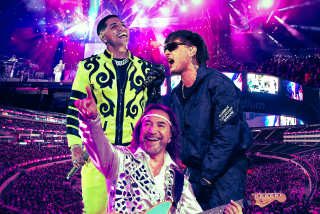STRUCTURES : Gruff Architectural Charm Highlights a Popular Nightspot : The 65-year-old Ventura Theater remains approachable as a concert venue due to its melange of motifs.
Ventura’s most dramatic theater space walks softly and carries a big volume. It doesn’t stand tall as a looming, singular edifice, like, say, Santa Barbara’s Arlington Theater, or the several venerable movie palaces still standing in Los Angeles.
One might actually drive right by the location at 26 S. Chestnut St. and fail to notice it, folded as it is into the architectural face of the block.
Chances are that anyone with a taste for night life knows exactly where the Ventura Theater is. Since 1988, it has been a user-friendly concert venue catering to a wide range of musical acts.
Equally wide ranging is the ambience of the structure, a melting-pot melange. Much of the long exterior adheres to a familiar Spanish Colonial vernacular. But how do you explain the neoclassical stuff of triple arches and double Corinthian columns, sitting atop a 1950 marquee replete with slanted neon lettering that screams postwar chic.
It’s your basic Mediterranean/classical/Art Deco/streamline moderne mutt. All the mixed metaphors add to the gruff charm of the place.
Inside, the words lavish and funky come to mind. Rococo decorative motifs abound, from the sunbursts and decorative gold leaf-lined foliage on the ceiling to the stately row of huge oval mirrors lining the upstairs lobby.
But there is also something loose and functional about the theater in its current state. It may be a historical landmark, but it’s no museum piece. Come as you are.
Recently, that seminal L.A. punk band X whipped a roughly 16- to 40-year-old crowd into a frenzy, past midnight. More than a thrashing display of revelry, from the bird’s-eye perspective up in the balcony, the show was also a lesson in architectural appreciation.
The band sent its eloquent sonic hailstorm sweeping up past the heaving humanity of the mosh pit, into the more sedate sections, up to the balcony--where the last remaining theater seats are--and rattling into the mirrored disco ball and the ceiling, all dressed up with nowhere to go.
On the occasion of its 65th birthday, the theater seems further away from retirement than ever.
It opened with a bang in 1928, a regional sensation designed by L.A. Smith, with interiors by Robert E. Power Studios. Theater owner Charles B. Corcoran, who had owned the American and Apollo theaters in Ventura, had the place built, and it was immediately recognized as a grand movie house in an age of grand movie houses.
On Aug. 16, 1928, a capacity crowd of 1,200 attended the world premiere of “Excess Baggage,” which had sound on its last reel. The theater originally played host to cinema and vaudeville.
Fifty years later, the Corcoran family sold the building to Dr. and Mrs. Angelo Elardo, who then leased it to Gary Folgner Management, which also runs the Coach House in San Juan Capistrano.
At that juncture, theater seats on the floor were removed to allow for a more flexible dinner-theater arrangement. Since then, the theater has realized a second life as a durable workhorse of a concert venue.
At a time when the state of movie theaters has largely devolved into strip mall multiplexes, and the economics of running a theater have changed radically, the Ventura Theater’s transformation stands as a kind of role model of architectural conservancy.
The Ventura Theater is a structure worth saving, and savoring.
Architecturally, the theater has its origins in the golden age of movie palaces and also reveals touches of kitsch dating from its ‘50s renovation. But it’s really more of a democratic affair, crossing boundaries of stylistic periods, of vulgarity and elegance, of steak and hamburger aesthetics.
You could say it’s a slice of architectural Americana pie, in the heart of Ventura.
More to Read
The biggest entertainment stories
Get our big stories about Hollywood, film, television, music, arts, culture and more right in your inbox as soon as they publish.
You may occasionally receive promotional content from the Los Angeles Times.










